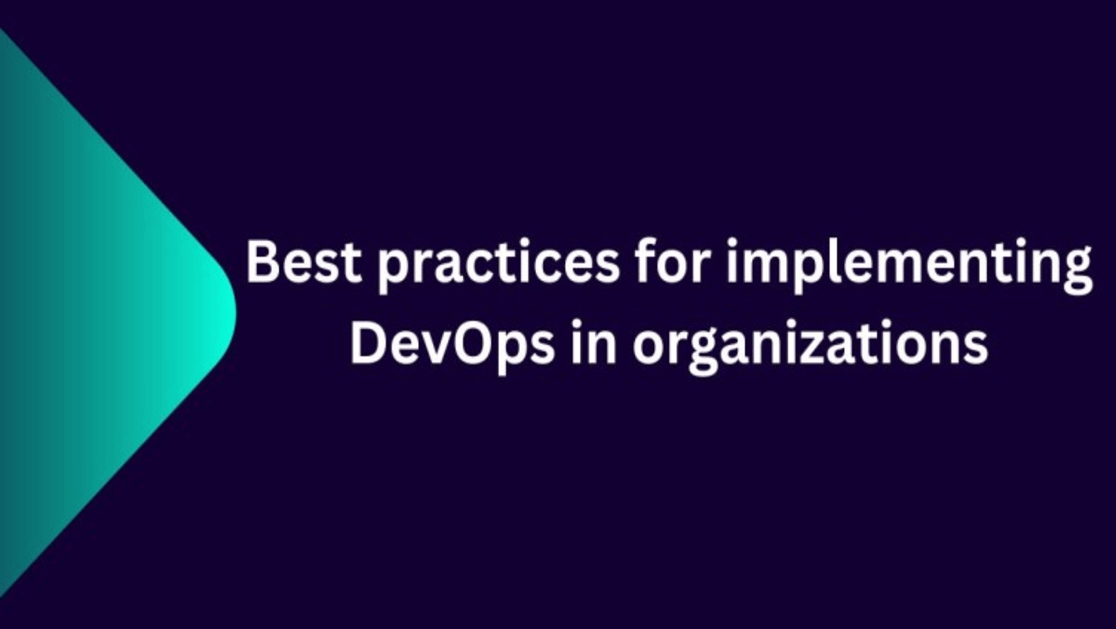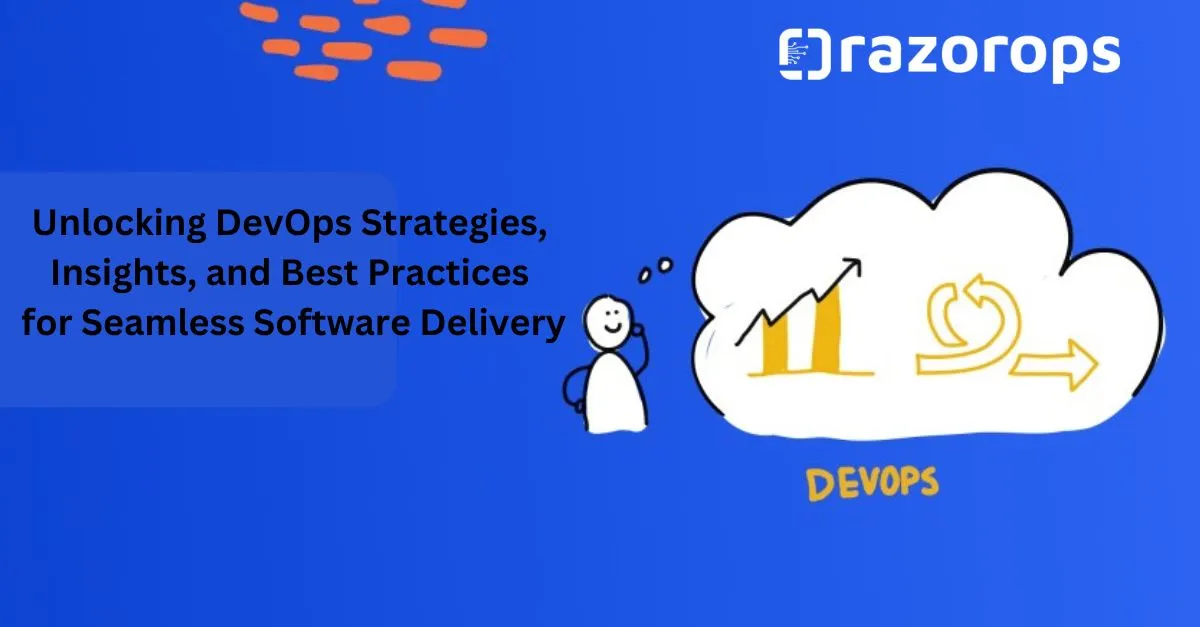Best Practices for implementing DevOps in Organizations

Are you curious about DevOps and how it’s transforming the world of technology? Look no further! In this blog, we will dive into the fascinating world of DevOps and explore its significance and need in today’s fast-paced digital landscape. From its definition and importance to real-world examples of epic fails and their solutions, we’ll cover it all. So, grab a cup of coffee, sit back, and let’s embark on this DevOps journey together!
What is DevOps?
DevOps is a software development methodology that emphasizes collaboration, communication, and automation between development (Dev) and operations (Ops) teams. It aims to break down the traditional silos between these teams and promote a culture of continuous integration, delivery, and improvement. DevOps enables faster software development and deployment, improved quality, and increased customer satisfaction.
The Importance and Need of DevOps in the Present World
In today’s fast-paced digital world, where businesses are constantly evolving, DevOps has become a crucial factor in software development and operations. The following are the key reasons why DevOps is important:
Faster Time to Market: DevOps allows for faster development cycles, automated testing, and continuous integration, enabling organizations to release software updates and new features quickly, giving them a competitive edge.
Improved Quality: DevOps emphasizes automated testing and monitoring, reducing the chances of software defects and vulnerabilities, leading to improved software quality and higher customer satisfaction.
Collaboration and Communication: DevOps promotes collaboration and communication between development and operations teams, breaking down traditional silos and fostering a culture of teamwork and shared responsibility, that results in smoother software development and operations processes.
Enhanced Efficiency: DevOps automates repetitive and manual tasks, reducing human errors and enabling teams to focus on more strategic and value-added activities, leading to improved operational efficiency.
Innovation and Flexibility: DevOps encourages experimentation, innovation, and iteration, allowing organizations to respond quickly to changing business requirements and market dynamics, driving continuous improvement and innovation.
Moving on, lets talk about the 5 incidents where DevOps didn’t work out well.
Lack of Culture Change: DevOps requires a cultural shift towards collaboration, trust, and accountability. One example is the failed launch of the healthcare.gov website in 2013, where poor communication and collaboration between the development and operations teams resulted in a disastrous rollout.
Solution: Organizations should prioritize cultural change by fostering a collaborative and inclusive work environment, promoting open communication, and encouraging shared ownership and accountability.
Insufficient Automation: Automation is a core principle of DevOps, and lack of automation can lead to manual errors, delays, and inconsistencies. One example is the 2012 Knight Capital Group’s trading glitch, where a manual deployment error cost the company $440 million.
Solution: Organizations should invest in automation tools and practices for tasks such as testing, deployment, and configuration management, to reduce human errors and ensure consistent and reliable software delivery.
Inadequate Monitoring and Feedback Loops: Monitoring and feedback are critical for identifying and resolving issues in real-time. One example is the 2017 Amazon Web Services (AWS) S3 outage, where inadequate monitoring led to widespread service disruptions for several hours.
Solution: Organizations should implement robust monitoring and alerting mechanisms, establish feedback loops between development and operations teams, and continuously analyze data to identify and address issues proactively.
Security Neglect: Security should be an integral part of DevOps practices, and neglecting security can result in vulnerabilities and data breaches. One example is the 2017 Equifax data breach, where a vulnerability in an open-source software component led to the exposure of sensitive data of 143 million customers.
Solution: Organizations should prioritize security by integrating security practices into the entire software development lifecycle, conducting regular security assessments, and implementing security controls and best practices.
Lack of Continuous Improvement: DevOps is based on the principle of continuous improvement, and failure to iterate and improve can result in stagnation and inefficiencies. One example is the failed migration of MyFitnessPal’s user data to a new system in 2018, where a lack of thorough testing and monitoring resulted in data corruption and prolonged service disruptions.
Solution: Organizations should embrace a culture of continuous improvement.
How DevOps is increasing the quality and speed of software delivery
DevOps has revolutionized the way software development and operations are approached in the modern world. Its emphasis on collaboration, automation, and continuous improvement has resulted in faster time to market, improved quality, enhanced efficiency, and increased innovation. However, as we’ve seen through real-world examples of DevOps failures, cultural change, automation, monitoring, security, and continuous improvement are crucial for successful DevOps implementation.
By addressing these challenges and embracing the principles of DevOps, organizations can unlock the full potential of this transformative methodology and thrive in the dynamic landscape of software development and operations. So, let’s continue to learn, adapt, and embrace the DevOps mindset to drive success in our technology-driven world!
Implementing DevOps in organizations requires a cultural shift and a significant change in the way software is developed, delivered, and maintained. Here are some best practices that can help organizations successfully adopt DevOps
Start with a clear vision and a strong business case: Organizations should define the goals of their DevOps transformation and establish a business case that outlines the benefits of DevOps for their specific needs.
Foster a culture of collaboration: DevOps emphasizes collaboration between development and operations teams. Organizations should encourage a culture of collaboration, communication, and teamwork across teams and departments.
Automate everything: Automation is a crucial aspect of DevOps. Organizations should automate everything from testing and deployment to infrastructure provisioning and configuration management.
Measure and monitor performance: DevOps requires continuous improvement, and organizations should measure and monitor their performance regularly to identify areas for improvement.
Implement continuous integration and continuous delivery (CI/CD): CI/CD is a key component of DevOps, allowing teams to deliver software faster and with higher quality. Organizations should implement CI/CD pipelines to automate software delivery processes.
Invest in the right tools: DevOps requires a range of tools for automation, monitoring, and collaboration. Organizations should invest in the right tools to support their DevOps practices.
Prioritize security: DevOps can improve the security of software delivery, but security must be integrated into DevOps practices from the beginning. Organizations should prioritize security and implement security best practices throughout the software development lifecycle.
Embrace a continuous learning mindset: DevOps is an ever-evolving practice, and organizations should encourage a continuous learning mindset to stay up-to-date with the latest trends and technologies in DevOps.
Best practices, organizations can successfully implement DevOps and realize the benefits of faster software delivery, improved collaboration, and higher quality software.
How the Razorops platform enhances the quality and speed of software delivery
Razorops is a DevOps platform that can help organizations automate their software delivery pipeline and improve the speed and quality of software delivery. Here are some insights into how DevOps with Razorops can improve the speed and quality of software delivery:
Automating Continuous Integration (CI) and Continuous Delivery (CD): Razorops provides a complete DevOps platform that can automate the entire software delivery pipeline, from building and testing code to deploying it to production. By automating CI and CD, teams can release software more frequently and with greater speed.
Easy Collaboration: Razorops enables teams to collaborate easily by providing a centralized platform for managing code, builds, and deployments. Teams can work together more effectively, breaking down silos and improving communication.
Improved Agility: Razorops enables organizations to be more agile by enabling them to respond quickly to changing business requirements. By automating the process of building and deploying code changes, teams can make changes more quickly and with greater ease.
Better Quality: Razorops provides tools for automating testing and monitoring, enabling teams to identify and fix issues quickly. By automating the testing process, teams can catch bugs and errors earlier in the development process, resulting in higher-quality software.
Increased Security: Razorops provides tools for integrating security into the software development lifecycle. By automating security testing and conducting regular security audits, teams can identify and mitigate security risks early in the development process.
DevOps with Razorops can help organizations improve the speed and quality of software delivery by automating CI and CD, promoting collaboration, improving agility, increasing quality, and enhancing security. By adopting DevOps practices with Razorops, organizations can streamline their software delivery pipeline and stay competitive in an ever-changing market.









